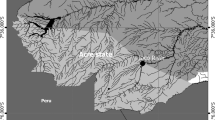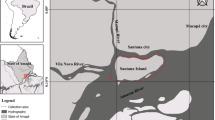Abstract
The present investigation evaluated the influence of seasonality and locality on the structure of the parasite community of the catfish Pimelodus blochii. A total of 160 fish were collected from two rivers in the State of Acre, western Brazilian Amazon: 80 fish in River Acre and 80 in River Iaco, with 40 in each season (rainy and drought). The overall prevalence was 78.7% and 1461 parasite specimens (adults and larvae) were allocated in 22 taxa: 5 of Monogenea, 10 of Nematoda, 3 of Digenea, 1 of Cestoda and 3 of Crustacea. In drought season, Procamallanus (Spirocamallanus) pimelodus and Demidospermus peruvianus were more prevalent in River Acre and Iaco, respectively. The parasite diversity (Brillouin index) as well as the prevalence and abundance of the monogeneans D. peruvianus, D. striatus, Demidospermus sp. and Ameloblastella sp. were higher in River Acre. The parasite community structure were dissimilar among rivers, and seasonally in River Iaco. These results suggest that environmental traits may overshadow seasonal influences on the parasite community structure, which may be related to the higher anthropization in River Acre. Furthermore, seasonality exerted less influence on the parasite community than expected, probably because the two rivers have different hydrological traits than those of other rivers in the Brazilian Amazon. New host and locality records expanded our knowledge of parasite biodiversity of P. blochii.

Similar content being viewed by others
References
Amarante CF, Tassinari WS, Luque JL, Pereira MJS (2015) Factors associated with parasite aggregation levels in fishes from Brazil. Rev Bras Parasitol Vet 24:174–182. https://doi.org/10.1590/S1984-29612015031
Bardales NG, Rodrigues TE, Oliveira H, Amaral EF, Araújo EA, Lani JL (2010) Formação, classificação e distribuição geográfica dos solos do Acre. In: Souza CM, Araújo EA, Medeiros MFST, Magalhãe AA (eds) Recursos naturais: geologia, geomorfologia e solos do Acre. SEMA, Rio Branco, pp 48–60
Bates D, Mächler M, Bolker B, Walker S (2015) Fitting linear mixed-effects models using lme4. J Stat Softw 67:1–51. https://doi.org/10.18637/jss.v067.i01
Blasco-Costa I, Rouco C, Poulin R (2014) Biogeography of parasitism in freshwater fish: spatial patterns in hot spots of infection. Ecography 37:1–10. https://doi.org/10.1111/ecog.01020
Burnham KP, Anderson DR (2002) Model selection and multimodel inference: a practical information-theoretic approach, 2 end edn. Springer, New York
Bush AO, Lafferty KD, Lotz JM, Shostak AW (1997) Parasitology meets ecology on its own terms: Margolis et al. revisited. J Parasitol 83:575–583. https://doi.org/10.2307/3284227
Carvalho AA, Tavares-Dias M (2017) Diversity of parasites in Cichlasoma amazonarum Kullander, 1983 during rainy and dry seasons in eastern Amazon (Brazil). J Appl Ichthyol 33:1178–1183. https://doi.org/10.1111/jai.13451
Cavalcante HO, Silva MT, Santos EGN, Chagas-Moutinho VA, Santos CP (2016) Orientatractis moraveci n. sp. and Rondonia rondoni Travassos, 1920 (Nematoda: Atractidae), parasites of Pimelodus blochii (Osteichthyes, Pimelodidae) from the Acre and Xapuri Rivers, Western Amazon, Brazil. Parasitology 144:226–236. https://doi.org/10.1017/S0031182016001736
Cavalcante PHO, Moravec F, Santos CP (2018) The philometrid nematode Philometroides acreanensis n. sp. from the stomach wall of the catfish Pimelodus blochii in north-western Brazil. J Helminthol 92:109–115. https://doi.org/10.1017/S0022149X1700013X
Dohoo I, Martin W, Stryhn H (2003) Veterinary epidemiologic research. AVC Inc., Charlottetown
Duarte AF (2017) Climatologia das chuvas e efeitos antrópicos da urbanização na Bacia do Rio Acre, Amazônia Ocidental. Bol Observ Amb Alberto Ribeiro Lamego 1:199–213. https://doi.org/10.19180/2177-4560.v11n12017p199-213
Eiras JC, Takemoto RM, Pavanelli GC (2006) Métodos de estudo e técnicas laboratoriais em parasitologia de peixes, 2nd edn. Editora da Universidade Estadual de Maringá, Maringá
Froese R, Pauly D (2018) FishBase. World Wide Web electronic publication. www.fishbase.org, version (02/2018)
Gil de Pertierra AA (2004) Redescription of Monticellia magna (Rego, Santos & Silva, 1974) (Eucestoda: Monticelliidae) parasite of Pimelodus spp. (Pisces: Siluriformes) from Argentina, and morphological study of microtriches. Rev Suisse Zool 111:11–20. https://doi.org/10.5962/BHL.part.80222
Hammer O, Harper DAT, Ryan PD (2001) PAST: Paleontological statistics software package for education and data analyses. Pelaeontologia Eletronica 4:1–9
Junk WJ (1997) The central Amazon floodplain: ecology of a pulsing system. Springer, New York
Kohn A, Fernandes BMM, Cohen SC (2007) South American trematodes parasites of fishes. Ed. Imprinta Express Ltda, Rio de Janeiro
López-Casas S, Jiménez-Segura LF (2007) Reproducción y hábitos alimenticios del nicuro, Pimelodus blochii (Valenciennes, 1840) (Pisces: Pimelodidae), en la ciénaga de cachimbero, río Magdalena, Colômbia. Actualidade Biológica 29:199–207
Lowe-McConnell RH (1999) Estudos ecológicos de comunidades de peixes tropicais. EDUPS, São Paulo
Lundberg JG, Littmann MW (2003) Family Pimelodidae (Long-whiskered catfishes). In: Reis RE, Kullander SO, Ferraris JRCJ (eds) Check list of the freshwater fishes of South and Central America. EDIPUCRS, Porto Alegre, pp 432–446
Luque JL, Tavares LER (2007) Checklist of Copepoda associated with fishes from Brazil. Zootaxa 1579:1–39. https://doi.org/10.11646/zootaxa.1579.1.1
Luque JL, Aguiar JC, Vieira FM, Gibson DI, Santos CP (2011) Checklist of Nematoda associated with the fishes of Brazil. Zootaxa 3082:1–88
Magurran AE (2004) Measuring biological diversity. Blackwell Publishing, Oxford
Mendoza-Palmero CA, Scholz T (2011) New species of Demidospermus (Monogenea: Dactylogyridae) of pimelodid catfish (Siluriformes) from Peruvian Amazonia and the reassignment of Urocleidoides lebedevi Kritsky and Thatcher, 1976. J Parasitol 97:586–592. https://doi.org/10.1645/GE-2655.1
Moravec F (1998) Nematodes of freshwater fishes of the Neotropical region. Academia, Praha
Neves LR, Pereira FB, Tavares-Dias M, Luque JL (2013) Seasonal influence on the parasite fauna of a wild population of Astronotus ocellatus (Perciformes: Cichlidae) from the Brazilian Amazon. J Parasitol 99:718–721. https://doi.org/10.1645/12-84.1
Oliveira MSB, Gonçalves RA, Ferreira DO, Pinheiro DA, Neves LR, Dias MKR, Tavares-Dias M (2017) Metazoan parasite communities of wild Leporinus friderici (Characiformes: Anostomidae) from Amazon River system in Brazil. Stud Neotropical Fauna Environ 52:146–156. https://doi.org/10.1080/01650521.2017.1312776
Orélis-Ribeiro R, Bullard SA (2015) Blood flukes (Digenea: Aporocotylidae) infecting body cavity of South American catfishes (Siluriformes: Pimelodidae): two new species from rivers in Bolivia, Guyana and Peru with a re-assessment of Plehniella Szidat, 1951. Folia Parasit 62:1–17. https://doi.org/10.14411/fp.2015.050
Palm HW (2011) Fish parasites as biological indicators in a changing world: can we monitor environmental impact and climate change? In: Mehlhorn H (ed) Progress in parasitology. Parasitology Research Monographs, vol 2. Springer, Berlin, pp 223–250. https://doi.org/10.1007/978-3-642-21396-0_12
Pereira TKK, Morais FJ (2015) Técnicas de geoprocessamento aplicadas aos problemas ambientais que afetam o rio Iaco dentro do limite do município de Sena Madureira-AC. Rev Eletron Gestão, Educação e Tecnol Amb 19:11–20. https://doi.org/10.5902/2236117013867
R Development Core Team (2008) R: a language and environment for statistical computing. Vienna, Austria
Reis RE, Kullander SO, Ferraris JRCJ (2001) Check list of the freshwater fishes of South and Central America. EDIPUCRS, Porto Alegre
Sánchez-Botero JI, Araújo-Lima CARM (2001) As macrófitas aquáticas como berçário para a ictiofauna da várzea do Rio Amazonas. Acta Amazon 31(3):437–447. https://doi.org/10.1590/1809-43922001313447
Sanchez-Ramires C, Vidal-Martinez VM, Aguirre-Macedo ML, Rodriguez-Canul RP, Gold-Bouchot G, Sures B (2007) Cichlidogyrus sclerosus (Monogenea: Ancyrocephalinae) and its host, the Nile tilapia (Oreochromis niloticus), as bioindicators of chemical pollution. J Parasitol 93:1097–1106. https://doi.org/10.1645/GE-1162R.1
Silva AEP, Angelis CF, Machado LAT, Waichaman AV (2008) Influência da precipitação na qualidade da água do Rio Purus. Acta Amazon 38:733–742. https://doi.org/10.1590/S0044-59672008000400017
Soares MGM, Costa EL, Siqueira-Souza FK, Anjos HDB, Yamamoto KC, Freitas CEC (2011) Peixes de lagos do médio Rio Solimões, 2nd edn. Instituto Piatam, Manaus
Tavares-Dias M, Oliveira MSB, Gonçalves R, Silva LMA (2014) Ecology and seasonal variation of parasites in wild Aequidens tetramerus, a Cichlidae from the Amazon. Acta Parasitol 54:158–164. https://doi.org/10.2478/s11686-014-0225-3
Wadt PGS, Araújo EA, Costa FS (2010) Manejo de fertilizantes e resíduos na Amazônia sul-ocidental. In: Prado RB, Turetta APD, Andrade AG (eds) Manejo e conservação do solo e da água no contexto das mudanças ambientais. Embrapa Solos, Rio de Janeiro, pp 141–170
Yamada FH, Bongiovani MF, Yamada POF, Silva FJ (2017) Parasite infracommunities of Leporinus friderici: a comparison of three tributaries of the Jurumirim Reservoir in southeastern Brazil. An Acad Bras Cienc 89:953–963. https://doi.org/10.1590/0001-3765201720160554
Zar JH (2010) Biostatistical analysis, 5th edn. Prentice Hall, New Jersey
Acknowledgements
Authors would like to thank Dr. Tomaš Scholz and Dr. Philippe Vieira Alves for the identification of cestodes as well as the staff of the Laboratory of Animal Parasitology from the Universidade Federal de Mato Grosso do Sul for support and providing research facilities.
Funding
M. T.-D. was supported by a researcher fellowship of the National Council for Research and Technological Development (Conselho Nacional de Pesquisa e Desenvolvimento Tecnologico, CNPq, Brazil) (# 303013/2015-0). F. B. P. was supported by a Post-doctoral fellowship PNPD-CAPES (Programa Nacional de Pós-Doutorado-Coordenação de Aperfeiçoamento de Pessoal de Nível Superior-CAPES, Brazil).
Author information
Authors and Affiliations
Corresponding author
Ethics declarations
Ethical Disclosures
All procedures involving animals were authorised by the Instituto Chico Mendes para Conservação da Biodiversidade (acronym SISBIO, N° 60899-1) and were strictly according to the protocols and rules of the Committee on Ethics of Animal Use of the Embrapa Amapá (Protocol No. 002-CEUA-CPAFAP).
Additional information
Section Editor: Guillermo Salgado-Maldonado
Luciano P. Negreiros and Felipe B. Pereira gave equal intellectual contribution for this publication.
Rights and permissions
About this article
Cite this article
Negreiros, L.P., Pereira, F.B., Tavares-Dias, M. et al. Community structure of metazoan parasites from Pimelodus blochii in two rivers of the Western Brazilian Amazon: same seasonal traits, but different anthropogenic impacts. Parasitol Res 117, 3791–3798 (2018). https://doi.org/10.1007/s00436-018-6082-5
Received:
Accepted:
Published:
Issue Date:
DOI: https://doi.org/10.1007/s00436-018-6082-5




